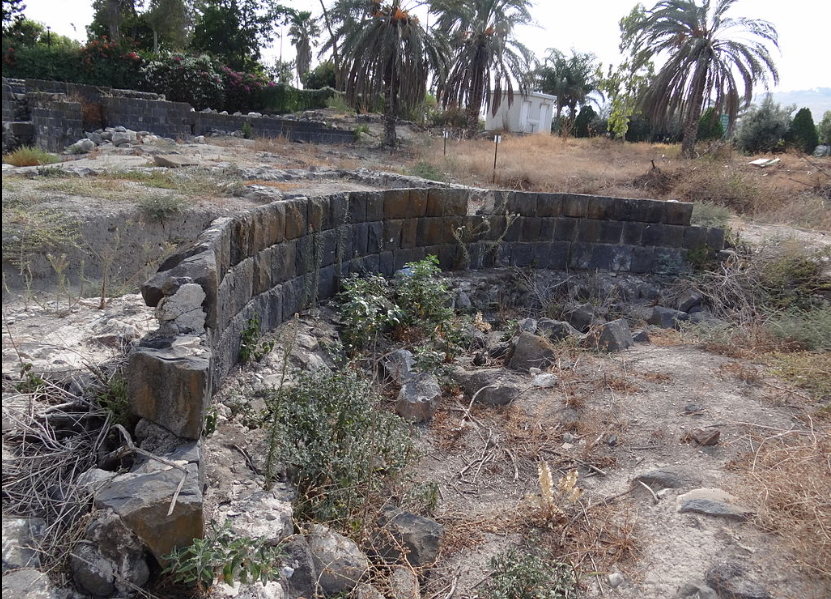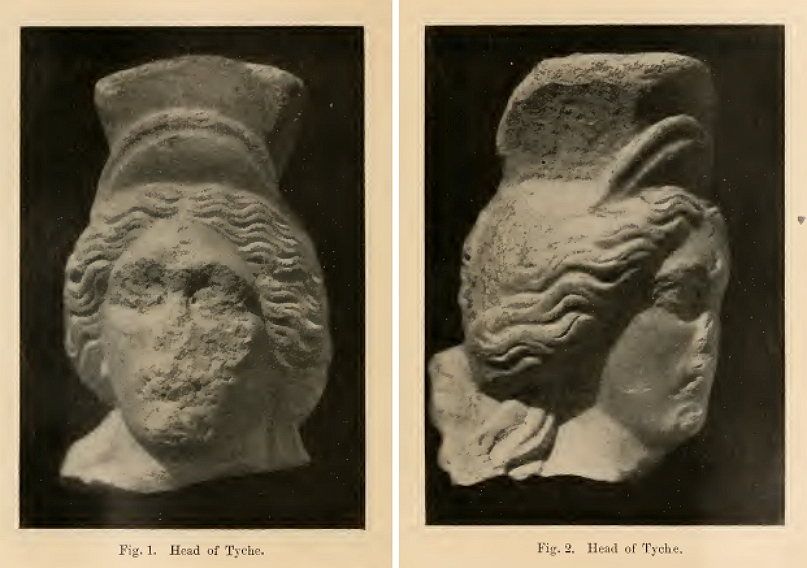, was also called Sennabris by Josephus.
The ancient predecessor settlements and also the common names today bears the name Khirbet el Kerak, Bet Yerah (House of the Moon).
In many cases, the name of the Bet - Yerah / Ariaḥ (ch) is also connected to the hills and plains lying here, but also for the hot springs a few kilometers north of the urban area (Hammat Ariaḥ (ch)). Bit Arḥ (ch) a a synonymous name is known. This may speak for an ancient cult around the moon and its sickle in this area around the Sea of Galilee. (thats why, the initial term Ark / Arca for a boat, is borrowed from the Moon, a sickle-shaped moon).
The city had a 1.6 km long city wall and at least one used even in Roman times fort of 54x54m (Kerak), right at the exit of the lake. According to A. Chancey there was also a complete antique bath with hot and cold pools.
The excavations also showed a 31x20 m sacral building,initially a synagogue, as well as a christian byzantine church built in the early 5th Century, rebuilt in the 6th century and finally destroyed at the beginning of the 7th century during a heavy earthquake . Many other Greek inscriptions could not be dated exactly.
Here, too, like in other decapolite cities, remains of an aqueduct from the hills in the southwest coming, both to the northern hot springs, as well as to the urban area.
 Ruinen einer Kirche in Philoteria Bet Yerah / Foto Hanay
Ruinen einer Kirche in Philoteria Bet Yerah / Foto Hanay Hypocausten in Philoteria Bet Yerah / Foto Hanay
Hypocausten in Philoteria Bet Yerah / Foto Hanay Ruinen von Philoteria Bet Yerah / Foto Hanay
Ruinen von Philoteria Bet Yerah / Foto HanayVarious coins found here from the Hellenistic period (Vinogradov 1992) lead to the conclusion that this place with Greek tradition was founded in the middle of the 3rd century BC, together with many other decapolis cities. The name of the City was taken from the sister and wife of the (new) founder ot the empire Ptolomaios Philadephos, which one had the Name Philoteria.
Although located here on the Jordan and the western end of the Sea of Galilee, Polybius Philoteria, as well as the cities of the Decapolis, reckons to "Coele Syria" and calls them together with Skythopolis. From the descriptions of Josephus, to Vespasian, again not the Greek, but the Talmudic name Sennabris on the way from Scythopolis to Tiberias is used. Further evidence of a flourishing Greek city in this place are not only the 2 slightly more south-facing bridges over the Jordan and the location at the main road links of this time, also the finding of a marble head, the Greek goddess and city goddess Agathe-Tyche can affirm this. (see also the treatise of L. Sukenik 1922)

The Philoteria does not appear in any of the "Decapolis lists" of that time, but this could be solved plausible with the given note to the Dekapolis regions surrounding the cities. There a "Arca" was mentioned by Pliny the Elder. (See also here under "The Decapolis") The derivation of the name Arca helps us as mentioned above to connect the Arca of Pliny with the region and the place of Philoteria /Sennabris (Ariaḥ (ch) - Bet Yerah).
Based on the listed evidence and the logical linkage to the urban areas of Gadara and Skythopolis, through the regional Polis of Arca , (with your at the same time newly founded capital Village of Philoteria), the topographical shape of the Decapolis region can clearly be harmonized.
The by Delougaz a.o. in 1960 discovered byzantine church, and a tomb of the Archimandrite of Helenopolis, not far from the neighboring village, suggest that this bishopric City actually was the succsessor Name of the greek Philoteria. Although the excavations of the church have not been published in detail, according to current state it should be noted that in this very area to this day the Christian tradition is rooted here. In addition to the now common baptismal site at the Jordan Valley near Jericho and the certainly correct, but now forgotten (proposed by the SWP of Conder, Wilson, Smith, Kitchener) Jordan ford called BethAbara northeast of Betshean, there also at the nearby place of Yardenit a strong baptismal tradition.
As a supplement, we should briefly refer to Kafr Kama, within certain literature identified with the bishopric of Heleno (u) polis. Certainly a significant site in terms of archaeological findings, however, the classical epoch is not comparable to El Kerak / Bet Yerah. The direct environment of Kafr Kama to the near bishoprics Eksalus (Iksal / Tabor), Tiberias and Nazareth also does not speak for this location. (See also Grootkerk)